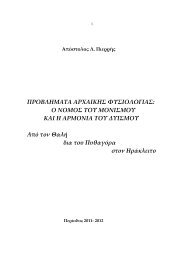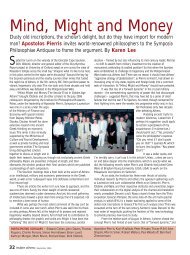chapter 10 the monism of darkness and the dualism of limit and ...
chapter 10 the monism of darkness and the dualism of limit and ...
chapter 10 the monism of darkness and the dualism of limit and ...
You also want an ePaper? Increase the reach of your titles
YUMPU automatically turns print PDFs into web optimized ePapers that Google loves.
78 CHAPTER <strong>10</strong><br />
iii. Moreover, according to <strong>the</strong> Scholia ad Theocritum XIII 1/2c p.<br />
258, 8 Wendel, Eros in Acousilaus’ <strong>the</strong>ology derives from Night <strong>and</strong><br />
Ae<strong>the</strong>r. Such variations in <strong>the</strong> formulation <strong>of</strong> parentage do not alter<br />
<strong>the</strong> basic congruence <strong>of</strong> <strong>the</strong> underlying accounts.<br />
11. The congress <strong>of</strong> Erebos <strong>and</strong> Nyx is a dualistic formulation<br />
(under <strong>the</strong> guise <strong>of</strong> male-female sexual intercourse) <strong>of</strong> a projection,<br />
procession or emanation from <strong>and</strong> by Night in Erebos, exactly as in<br />
<strong>the</strong> Aristophanic <strong>the</strong>ogony, Aves (414 B.C.) 694-5:<br />
\EÚ¤‚Ô˘˜ ‰’ âÓ àapple›ÚÔÈÛÈ ÎfiÏappleÔȘ<br />
Ù›ÎÙÂÈ appleÚÒÙÈÛÙÔÓ ñappleËÓ¤ÌÈÔÓ NfÍ ì ÌÂÏ·ÓfiappleÙÂÚÔ˜ ˇèfiÓ,<br />
âÍ Ôy appleÂÚÈÙÂÏÏÔ̤ӷȘ œÚ·È˜ ö‚Ï·ÛÙÂÓ òEÚˆ˜ ï appleÔıÂÈÓfi˜,<br />
ÛٛςˆÓ ÓáÙÔÓ appleÙÂÚ‡ÁÔÈÓ ¯Ú˘Û·ÖÓ, ÂåÎg˜ àÓÂÌÒÎÂÛÈ ‰›Ó·È˜.<br />
We have here <strong>the</strong> derivation <strong>of</strong> Light (golden-winged glittering <strong>and</strong><br />
brilliance) from Darkness (black-winged Night), <strong>the</strong> spiritual (breathlike)<br />
nature <strong>of</strong> <strong>the</strong> creative principle (Eros being like a windy whirl <strong>and</strong><br />
mighty spin) <strong>and</strong> <strong>the</strong> maleless generation <strong>of</strong> <strong>the</strong> cosmic egg 33 . The<br />
locative significance <strong>of</strong> Erebos’ existence is more emphatically stressed<br />
in <strong>the</strong> phantastic genealogy <strong>of</strong> <strong>the</strong> birds which Aristophanes later plays<br />
with (698 sqq.):<br />
ÔyÙÔ˜ (sc. òEÚˆ˜) ‰b X¿ÂÈ appleÙÂÚfiÂÓÙÈ ÌÈÁÂd˜ Ó˘¯›ˇˆ ηÙa<br />
T¿ÚÙ·ÚÔÓ ÂéÚfÓ<br />
âÓÂfiÙÙ¢ÛÂÓ Á¤ÓÔ˜ ì̤ÙÂÚÔÓ Î·d appleÚáÙÔÓ àÓ‹Á·ÁÂÓ Âå˜ Êá˜.<br />
(ÙÂÚfiÂÓÙÈ is employed because <strong>of</strong> <strong>the</strong> general ornithological<br />
emphasis on fea<strong>the</strong>rs <strong>and</strong> wings in this passage which is uttered by<br />
birds. A true <strong>the</strong>ogony would have äÂÚfiÂÓÙÈ, air as dark, thick mist, as<br />
in Homer). If we make exception for Tartarus <strong>and</strong> Chaos which are<br />
used only sportively in this humorous Ornithology (<strong>and</strong> which satirize<br />
<strong>the</strong> over-elaborate duplications <strong>and</strong> multiplications <strong>of</strong> similar<br />
coordinated principles that we find in cosmogonic <strong>and</strong> <strong>the</strong>ogonic<br />
genealogies), we are left, as <strong>the</strong> basic scheme <strong>of</strong> <strong>the</strong> Aristophanic<br />
Cosmogony, with Night (<strong>and</strong> Erebos), <strong>the</strong> Egg, Eros <strong>and</strong> <strong>the</strong><br />
formation <strong>of</strong> <strong>the</strong> fundamental structures <strong>and</strong> parts <strong>of</strong> <strong>the</strong> World that










